Fo c k e W u l f Ta 15 2 H -1 Fo c k e W u l f Ta 15 2 H -1
Die Ta 152 war eine Weiterentwicklung der mit einem Reihenmotor ausgerüsteten Fw 190 D
und wurde nach dem Scheitern der Bf 109 H besonders dringlich, da das RLM neben den alli-
ierten Höhenaufklärern mit dem Einsatz des Langstreckenbombers B-29 mit Druckkabine
rechnen musste. Das ab Frühjahr 1945 in geringer Stückzahl zum Einsatz gebrachte Höhen-
Jagdflugzeug Ta 152 H-1 erwies sich als das leistungsfähigste Jagdflugzeug der deutschen
Luftwaffe mit Kolbentriebwerk. Es war das erste in Serie produzierte Jagdflugzeug mit druck-
dichter Kabine. Die unter Leitung des Chefkonstrukteurs Prof. Kurt Tank bei der Firma Focke-
Wulf Flugzeugbau GmbH ab Mitte 1943 entwickelte Maschine sollte weitgehend mit den vor-
handenen Bauvorrichtungen und Werkzeugen der Fw 190 A-8 sowie unter Verwendung von
Stahlblech und Holz statt Aluminium produziert werden. Unter anderem war neben der Ta
152 H eine Zerstöre r-Vari ante Ta 152 C mi t vier MG 151/15, ein er MK-108- Motorka none und
dem Einheitstriebwerk DB 603 LA vorgesehen. Die Höhen-Variante sollte dagegen mit einer
neu konstruierten Tragfläche, Druckkabine, dem Einheitstriebwerk Jumo 213 E-1 mit GM-1-
Anlage und der Methanol-Wasser-Einspritzanlage MW-50 ausgerüstet werden. Der Hoch -
leistungs motor Jumo 213 E-1 besaß einen zweistufigen Lader mit automatischem Dreigang-
Schaltgetriebe und Ladeluftkühler. Er wurde ab 1944 in größeren Stückzahlen als sogenann-
tes Jägertriebwerk mit Stirnkühler, Motorgerüst, Regeleinrichtungen, Generator und vollstän-
diger Verkleidung gefertigt. Der Austausch dieser Triebwerks-Anlagen nahm nur wenig Zeit in
Anspruch. Durch die MW-50 Anlage erhöhte sich die Motorleistung bis 9.800 Meter Höhe um
220 kW (300 PS). Mit der GM-1-Anlage lies sich die Leistung ab 9.800 Meter Höhe durch das
Einspritzen von Stickoxidul in den Ladereinlauf um bis zu 295 kW (400 PS) steigern. In den zum
Teil aus Stahlblech gefertigten Tragflächen der Variante H-1 wurden 6 ungeschützte
Sackbehälter für 400 Liter Treibstoff und 70 Liter MW-50 eingesetzt. Unterhalb des Kabinen -
bodens gab es zwei beschußsichere Behälter mit gesamt 595 Liter Fassungsvermögen. Hinter
der Kabine befand sich der MW-50 Behälter mit 140 Liter Inhalt. In Flugzeugmitte war die
Tanklafette Ta 152 in den Rumpfboden eingelassen, an die ein 300-Liter-Zusatzbehälter ange -
hängt werden konnte. Zur Versorgung der Druckkabine mit Atemluft war an das Triebwerk
ein Kompressor angeflanscht, der ab 8.000 Meter Höhe den Innendruck automatisch geregelt
konstant hielt. Die Schiebehaube war doppelwandig und mittels Gummilippen selbstdichtend
ausgelegt. Das Plexiglas war aussen 6 und innen 4 Millimeter dick. Die Abdichtung des Cock -
pits mit Dichtpaste und Gummi-Formteilen bereitete große Schwierigkeiten. Das Rumpfheck
mit Seitenleitwerk und Höhenflosse bestand aus Holz. Insgesamt sind bis Kriegsende nach-
weislich 42 Ta 152 H produziert worden. Die erste fertiggestellte Maschine erreichte die Erpro -
bungs stelle Rechlin am 11. Dezember 1944. Das Jagdgeschwader 301 erhielt die ersten Ta 152
H am 27. Januar 1945. Wegen Treibstoffmangels wurden die Maschinen nur noch wenig geflo-
gen. Die einzige erhaltene Ta 152 ist im Depot des NASM Washington eingelagert.
Technische Daten:
Spannweite: 14,82 m; Länge: 10,82 m; Höhe: 3,36 m; Flügelfläche: 23,50 m; Leergewicht: 3.920
kg; Startgewicht: maximal 5.215 kg; Triebwerk: V-12-Motor Jumo 213 E-1; Hubraum: 35 Liter;
Propeller: Junkers VS-9 Holzpropeller mit 3,6 m Durchmesser; Startleistung: 1.370 kW (1.870
PS); 1.511 kW (2.050 PS) mit MW-50-Zusatzeinspritzung; Höchstgeschwindigkeit: 730 km/h in
9.500 m Höhe (ohne MW-50); 550 km/h in Bodennähe; Marschgeschwindigkeit: 500 km/h;
Steiggeschwindigkeit: 1.050 m/min; Dienstgipfelhöhe: 14.800 m; Reichweite: 1.200 km;
Bewaffnung: eine 30-mm-MK 108 (90 Schuss); zwei 20-mm-MG 151/2 0 ( je 175 Schuss)
The Ta 152 was a further development of the in-line engined Fw 190 D which after the failu-
re of the Bf 109 H was urgently required as the RLM (Imperial Aviation Ministry) had to coun-
ter the allied B-29 long-range bombers with pressurized cabins, in addition to high altitude
reconnaissance aircraft. Brought into use in limited numbers from the spring of 1945 the High-
altitude Ta 152 H-1 fighter proved to be the Luftwaffe's most powerful piston engine fighter.
It was the first mass produced fighter aircraft with a pressurized cabin. Developed from mid
1943 onwards under the direction of chief designer Prof. Kurt Tank at the Focke-Wulf Aircraft
Factory Ltd, the aircraft could largely be produced using existing jigs and tools for the Fw 190
A-8 but using steel sheet and wood instead of aluminium. In addition to the Ta 152 H, an
attack version - the Ta 152 C was armed with four MG 151/15, a MK- 108 Machi ne Canon and
the standardised DB 603 LA engine was also projected. The high altitude variant however, was
to be fitted with a redesigned wing, a pressurized cabin, the standardized Jumo 213 E-1 engi-
ne with GM-1 unit and the MW 50 methanol-water injection system. The Jumo 213 E-1 high-
performance engine had a two-stage supercharger with a three-speed automatic transmissi-
on and charge air cooler. It was manufactured in larger numbers during 1944 and known as
the “Fighter Engine” with front radiator, engine mounts, control units, generator and a com-
plete fairing. Changing these engine “packs” took no time at all. Using the MW-50 injection
system increased the power output at 9,800 meters (32000 ft) by 220 kW (300 Bhp). With the
GM-1 unit, the power above 9,800 meters was increased by up to 295 kW (400 HP) by injec-
ting nitrous oxide into the supercharger. In the H-1 variant, six unprotected bag tanks for 400
litres of fuel and 70 litres MW-50 were housed within the wings which were partly made of
sheet steel. Below the cabin floor there were two bullet-proof tanks with a total of 595 litres.
Behind the cabin was a MW-50 tank with a 140 litre capacity. A Ta 152 attachment cradle for
a 300 litre (66 gal) drop tank was incorporated into aircraft under-belly. A compressor which
automatically controlled cockpit air pressure and held it constant above 8000 m (26000 ft) was
flanged onto the engine. The sliding canopy was designed to be self-sealing by means of
double-layered rubber lips. The Perspex was 6mm thick outside and 4mm thick inside. Sealing
the cockpit with sealing paste and moulded rubber parts caused great difficulties. The rear
fuselage including fin and tailplane were made of wood. Up to the end of the war a confir-
med total of 42 Ta-152H were built. The first completed aircraft arrived at the Rechlin Test
Centre on 11 December 1944. Jagdgeschwader (Fighter Wing) 301 received the first Ta 152H
in 27 January 1945. The aircraft were only flown sporadically due of fuel shortages. The only
remaining Ta 152 is stored in the NASM depot in Washington.
Technical Data:
Wingspan: 14.82 m (48ft 7ins); Length: 10.82 m (35ft 6ins); Height: 3.36 m (11ft); Wing Area:
23.50 m (253 sq ft); Empty Weight: 3920 kg (8644lbs); Maximum Take-off Weight: 5215 kg
(11500 lbs) ; Engine : V-12 Jum o 213 E-1; Cubic Ca pacity: 35 Litre; Prope ller: Ju nkers VS -9
Wooden Propeller with 3.6 m (11ft 10ins) Diameter; Take-off Power: 1370 kW (1870 Bhp); 1511
kW (2050 Bhp) with MW-50-Fuel Injection; Maximum Speed: 730 km/h (450mph) at 9500 m
(31160 ft ) w it hout M W-5 0; 550 km/h (34 0mph ) a t Low Level; Crui sing Spe ed: 500 km/h
(310mph); Rate of Climb: 1050 m/min (3440ft/min); Service Ceiling: 14800 m (48500ft); Range:
1200 km (745 miles); Armament: One MK 108 30mm (90 rounds); Two 20mm MG 151/20
(each 175 Rounds)


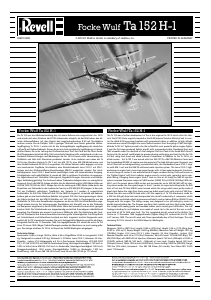

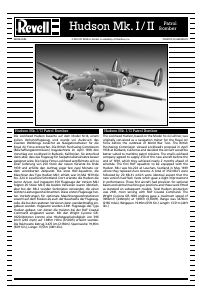
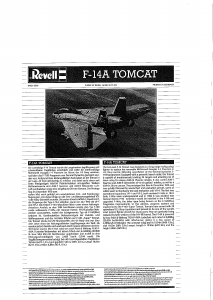
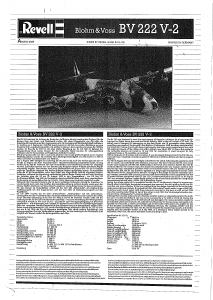
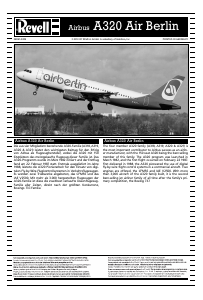
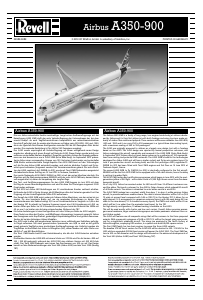
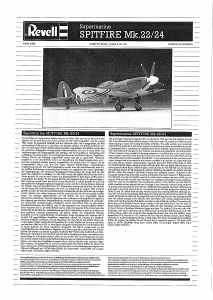
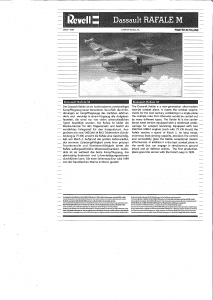
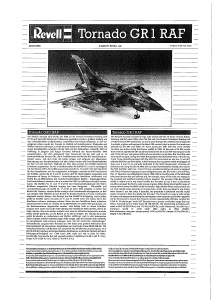
Joignez-vous à la conversation sur ce produit
Ici, vous pouvez partager ce que vous pensez du Revell set 03981 Airplanes Focke Wulf Ta 152 H. Si vous avez une question, lisez d’abord attentivement le mode d’emploi. La demande d’un mode d’emploi peut être effectuée en utilisant notre formulaire de contact.